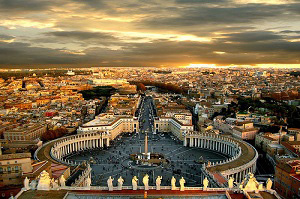
Getting around Rome
The relatively small size of the city centre, together with the vast amounts of tourist over the year and Italians’ refusal to park more than five meters away from the place that they have to go, means that traffic at times is dense. But there is hope: you’ll discover that surprisingly many destinations are close to each other. Many of the attractions described in this guide are easily reached on feet. Together with the two metro lines, there is a vast network of buses and trams that will get you to your destination. In comparison with other cities, taxis are relatively affordable. Bikes are rather uncommon, although there are few bike rentals, for instance in the Villa Borghese park. For Romans, bicycles are more seen as a toy than as a serious means of transport.
Metro Rome
Rome is equipped with only two metro lines. The famous Italian lack of organisational talent, and the massive amount of archeologically valuable goods in the ground have caused tremendous delays to the completion of the third line. Having said that, metro A and B run often and are of great use to the tourist travelling around. Both lines cross at Termini, the main railway station. Line A goes from the south, in proximity of the Ciampino airport to the west of the city, passing the Spanish steps, Villa Borghese park and the Vatican. Line B runs from the southern neighbourhood EUR up north, passing the gorgeous San Paolo fuori le mura church, the southern train station Ostiense, the Coliseum and the student area of Policlinico and piazza Bologna. You can buy tickets inside all metro stations and will need them to open the turnstiles. Be aware of pickpockets in the metro, especially on tourist routes.
Bus and tram Rome
The public transport in the centre is quite good. Buses are going all around the city and relatively often, although the schedules are not always adhered too and you might have to wait a bit when there is a lot of traffic. At rush hour, buses might be a bit full. Watch out for pickpockets in the buses: express bus 40 from Termini station to Castel Sant’Angelo (near St. Peter Cathedral) is notorious. There are several tramlines (for example in Trastevere), but most parts are served by bus. To check your route, go to www.atac.roma.it.
Train Rome
There are train stations at several sides of the city: Termini in the middle, Ostiense to the south, Trastevere to the west, Tiburtuna to the east and some more. Termini is a central point of the city. Trains from many major Italian cities arrive here and it is also the point where metro A and B meet. Termini is connected with the airport of Fiumicino. In case you are planning to see something of the area around Rome by train, you’ll most likely depart from Ostiense or Tiburtuna. Check the routes and schedule on www.trenitalia.it.
Getting from the airport to the city centre
From both airports, the taxi is an easy yet costly means of transport to the city. From Fiumicino, most people prefer to take the direct train to Rome Termini, the main station. Trains are leaving every half hour. The duration of the trip is thirty-one minutes. For the exact schedule, see www.trenitalia.it. From Ciampino, you have several options. The easiest way to the city centre is to take one of the coaches, mostly run by private companies as Terravision (www.terravision.eu) and Cotral (www.cotralspa.it). Generally, these buses are leaving every forty minutes. The duration of the ride depends on the traffic, but should be around forty minutes. To save a little bit of money, you also can choose to take the Cotral bus to metro stop Anagnina, where you can take metro A (or a city bus) to your destination. If you take this route, be sure you don’t get off at the train station of Ciampino where the many buses stop before getting to Anagnina; trains from Ciampino to central Rome are running not too often.
